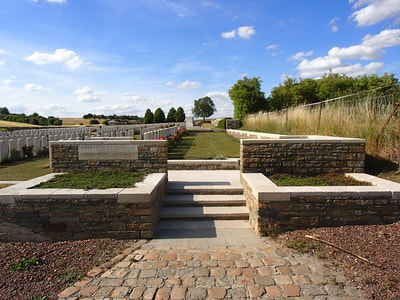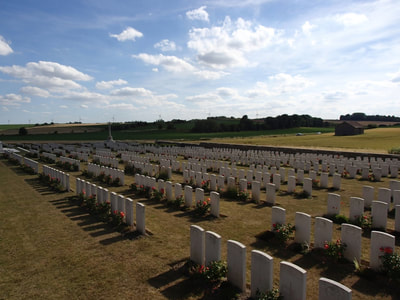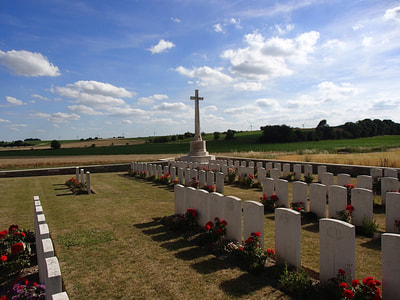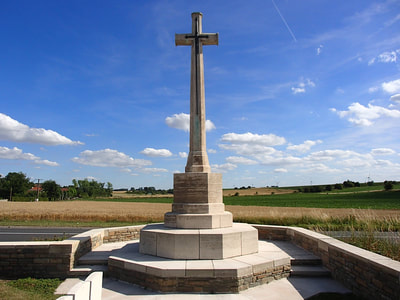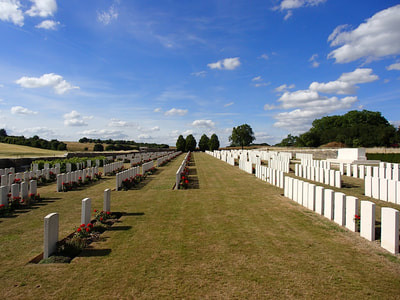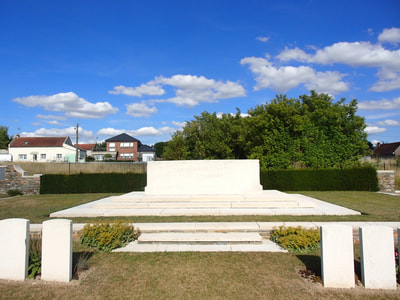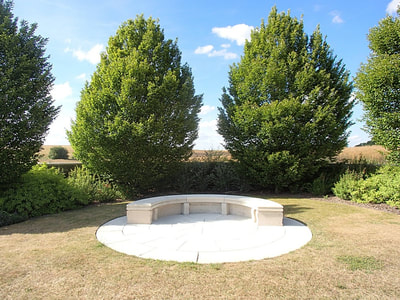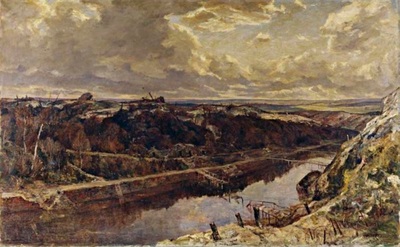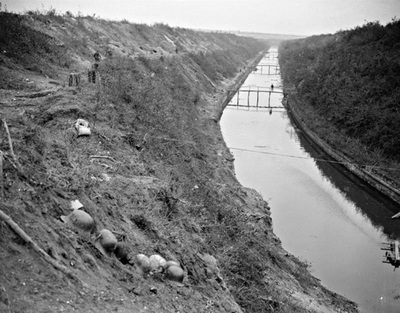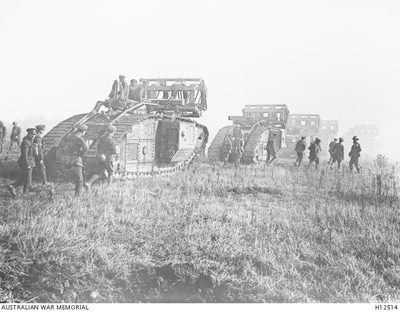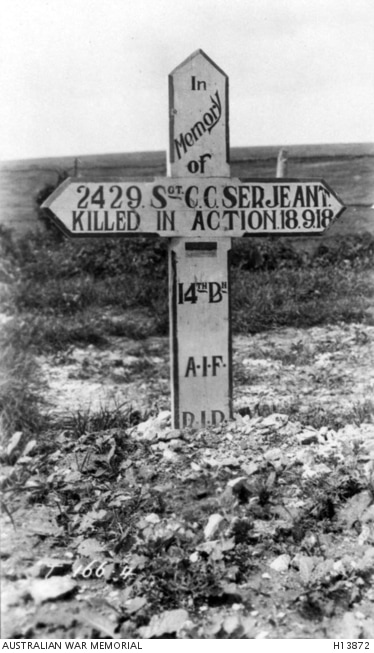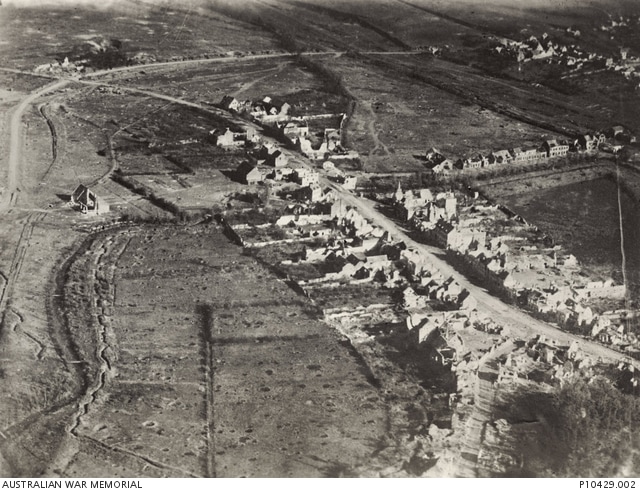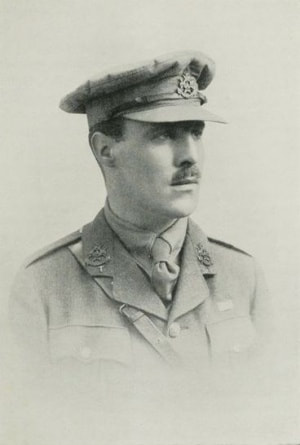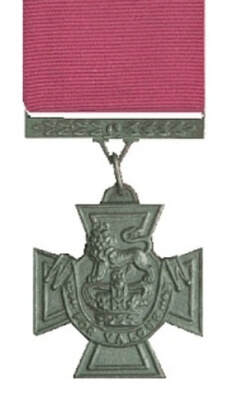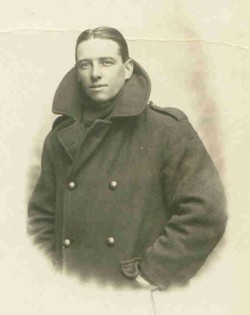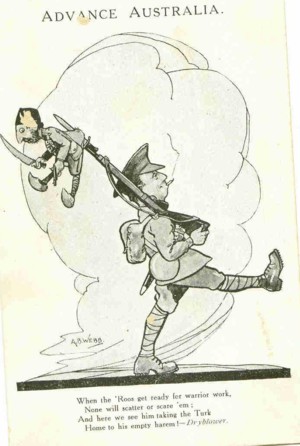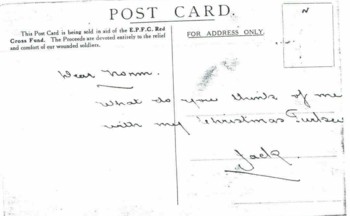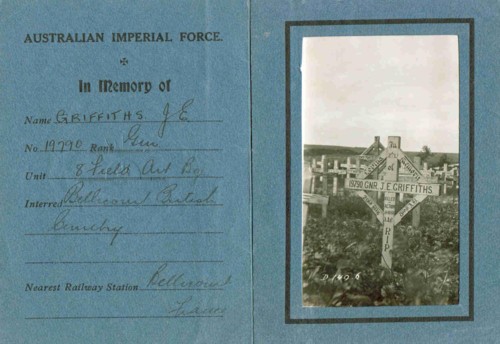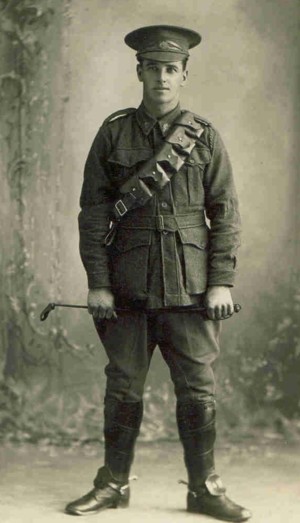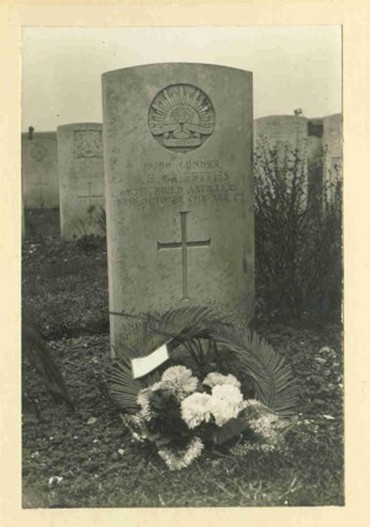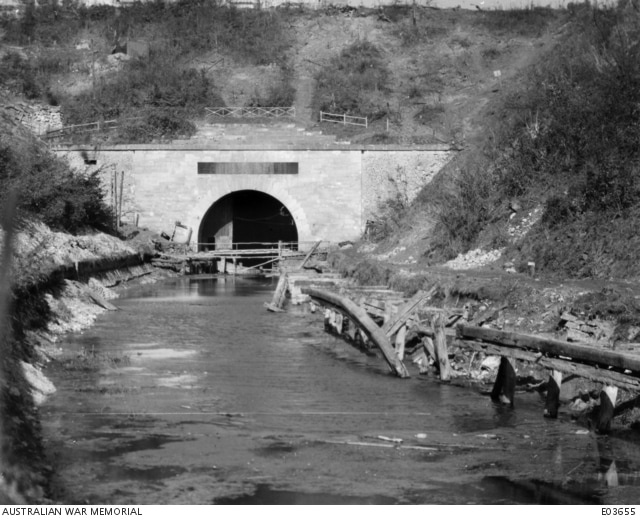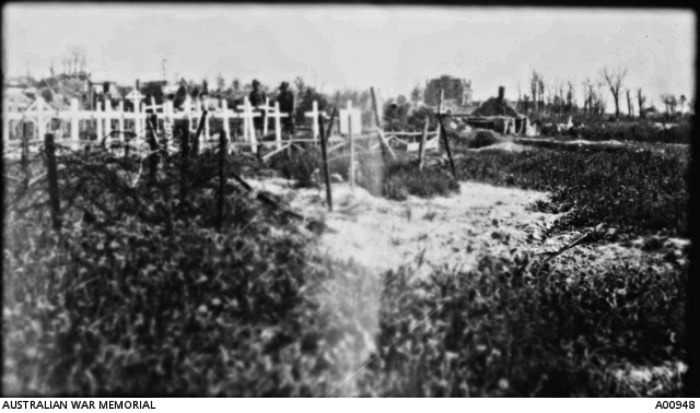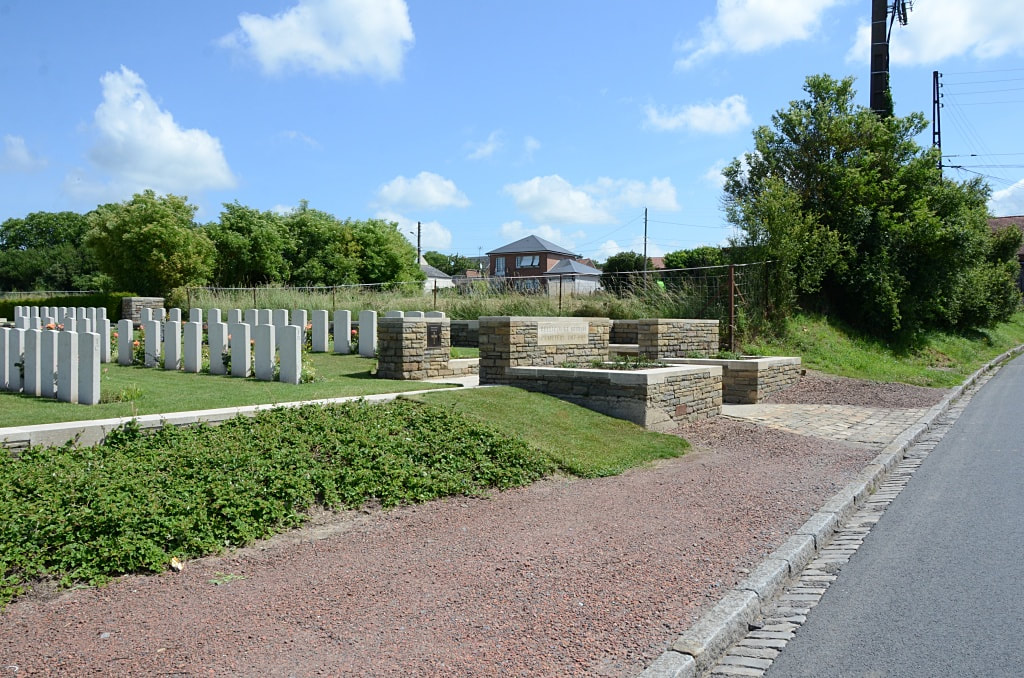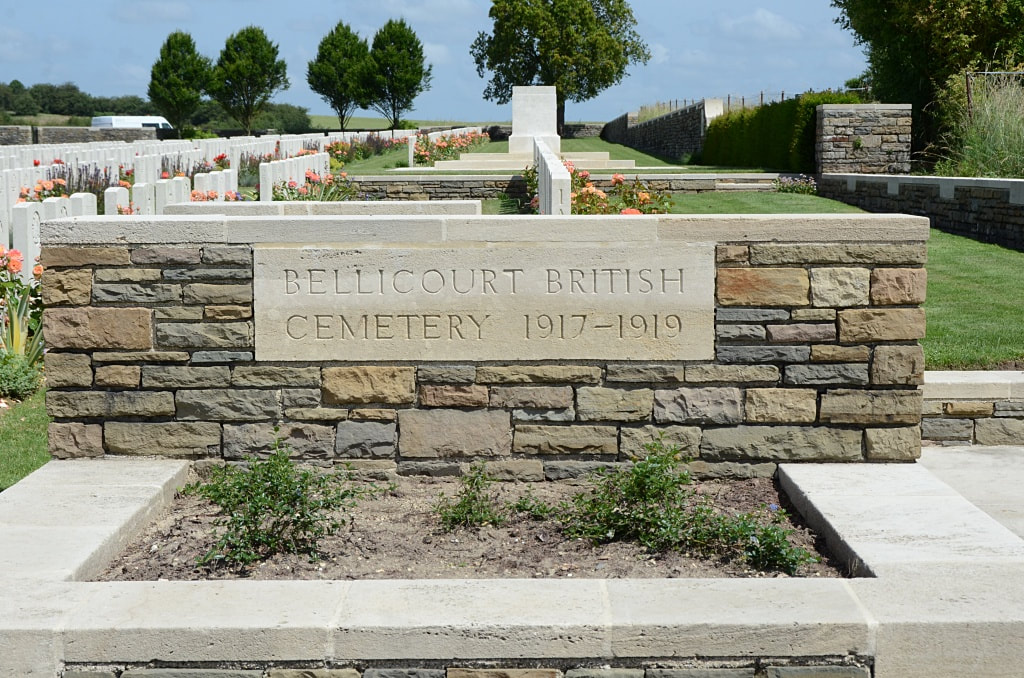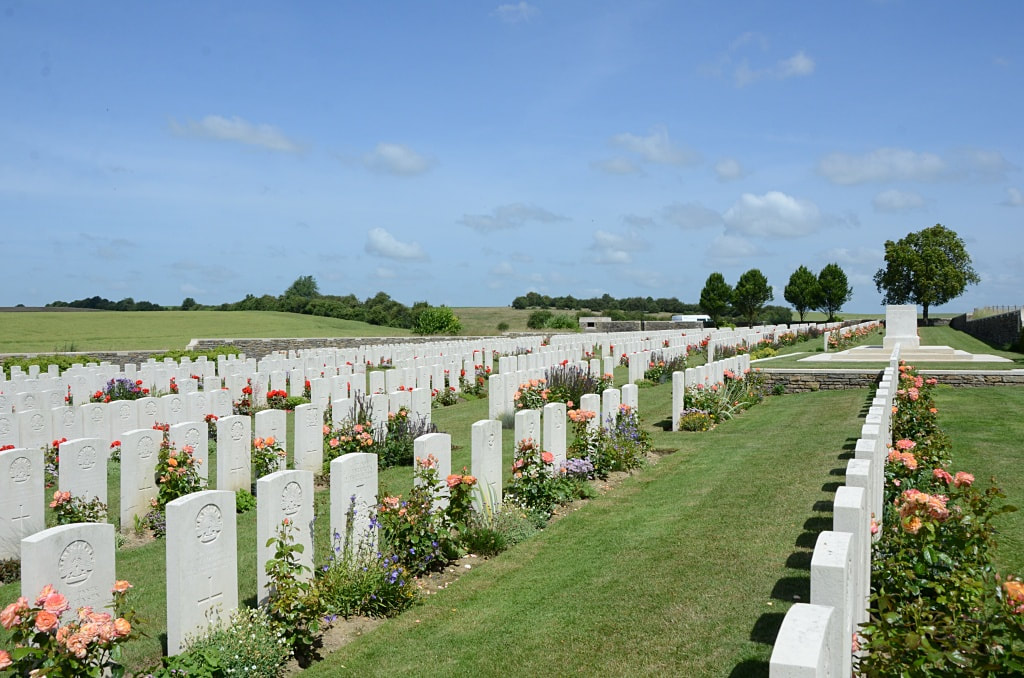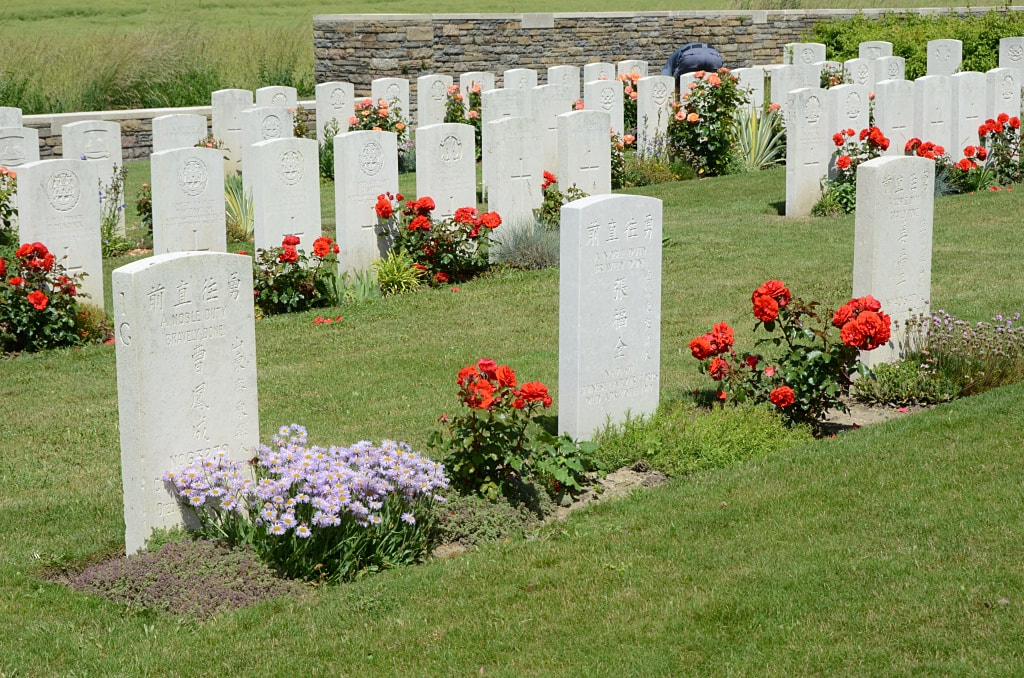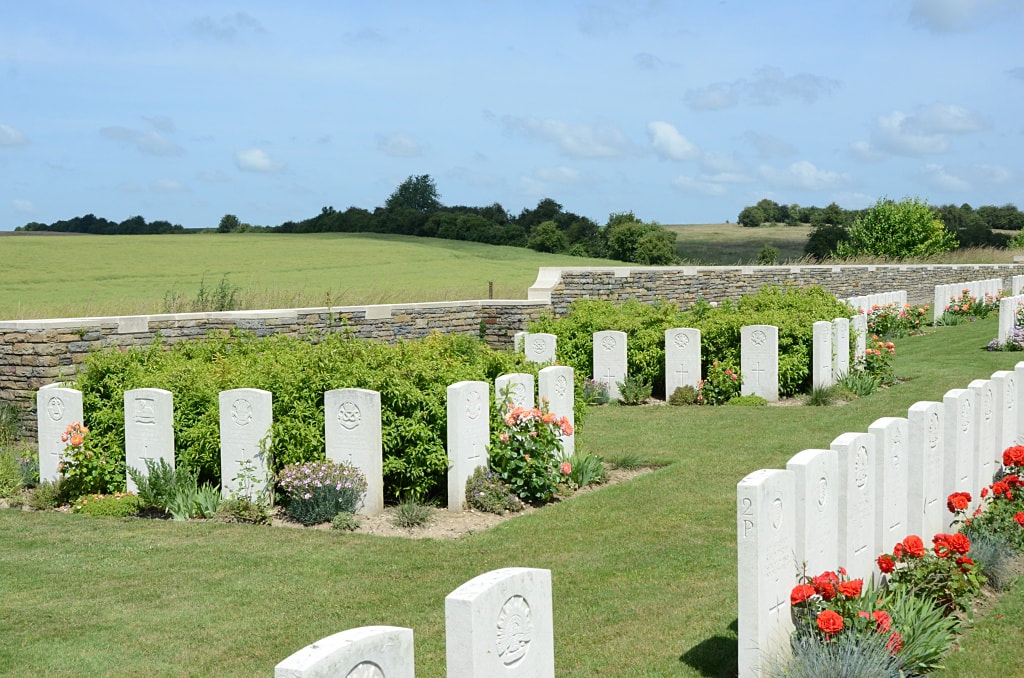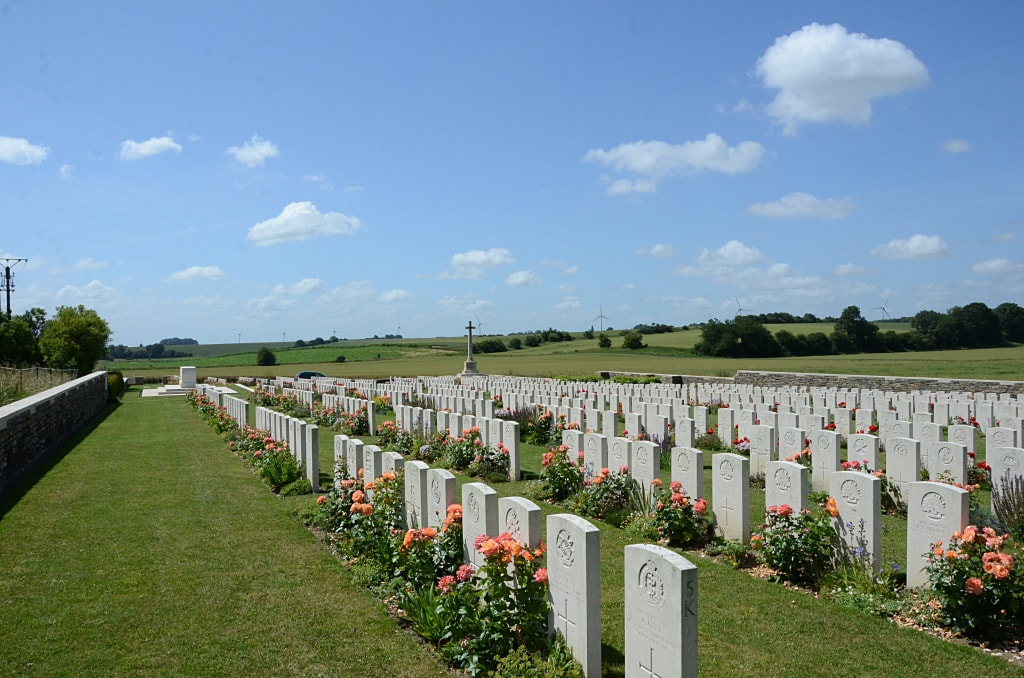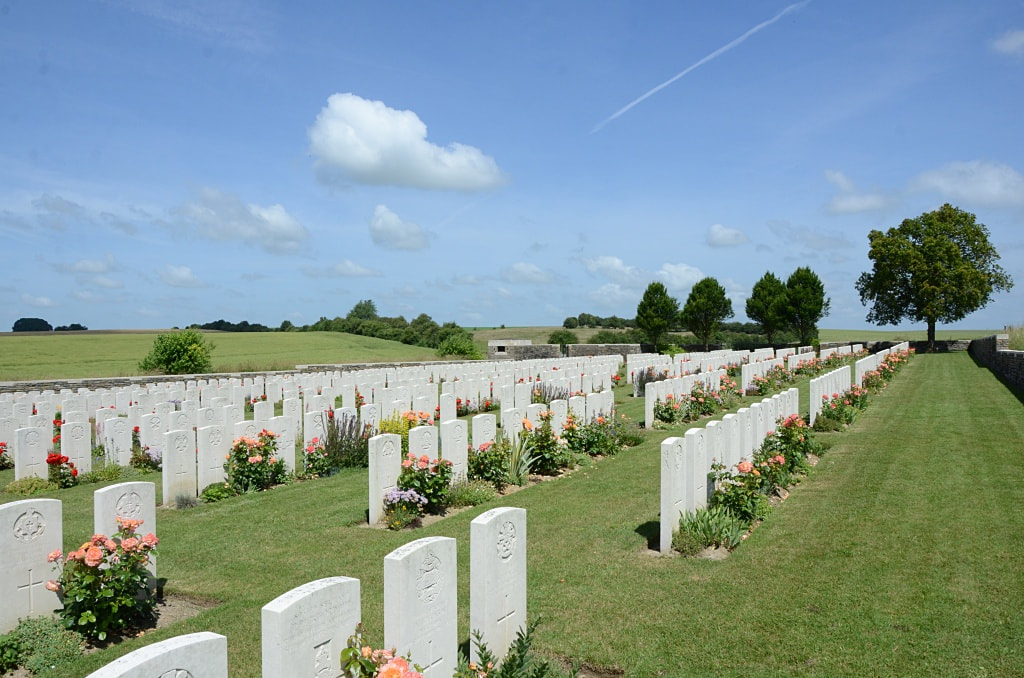BELLICOURT BRITISH CEMETERY
Aisne
France
GPS Coordinates: Latitude: 49.96128, Longitude: 3.22899
Location Information
Bellicourt is a village 13 Kms north of St. Quentin and 28 Kms south of Cambrai on the N44 road which connects the two cities.
The Cemetery is signposted at the junction of the D331 and N44 and is 100 metres from the main road along the D331 in the direction of Peronne.
Historical Information
The Canal de St. Quentin passes under the village of Bellicourt in a tunnel 5 Kms long, built under the orders of Napoleon I. The Hindenburg Line ran west of the village, and the barges in the tunnel were used to shelter German reserves. About 5 Kms south of Bellicourt, where the canal is open, is the village of Bellenglise, where another great tunnel or dug-out was made by the Germans.
On 29 September - 2 October 1918, the Battle of the St. Quentin Canal was fought. The 46th (North Midland) Division stormed the Hindenburg Line at Bellenglise and captured 4,000 prisoners and 70 guns. The 30th United States Division captured Bellicourt and Nauroy, which were cleared by the 5th Australian Division. The North Midland and Australian dead of this engagement fill most of the graves in Bellicourt British Cemetery.
The cemetery was made after the battle, when 73 dead were buried in what is now Plot I. It was greatly enlarged after the Armistice, when graves were brought from the surrounding battlefields and the following smaller cemeteries:-
BELLENGLISE BRITISH CEMETERY, in a field across the canal. It was made by the IX Corps in November, 1918, and almost all the 48 graves in it were those of men of the 46th Division.
CARRIERE BRITISH CEMETERY, BELLICOURT, by a quarry on the East side of the Bellicourt-Bellenglise road. It contained the graves of 27 soldiers from Australia and eight from the United Kingdom who fell in October, 1918.
JONCOURT RAILWAY CEMETERY, on the North side of Joncourt Station, containing the graves of 22 Australian soldiers who fell in October, 1918.
MAGNY-LA-FOSSE BRITISH CEMETERY, at the East end of the village of Magny-la-Fosse, made by Field Ambulances in October, 1918 and containing the graves of 37 soldiers and airmen from the United Kingdom.
MELBOURNE CEMETERY, MONTBREHAIN, on the South side of the Montbrehain-Ramicourt road, containing the graves of 15 Australian soldiers (13 of whom belonged to the 24th Battalion, from Victoria,) who fell on the 5th October, 1918.
MONT-ST. MARTIN BRITISH CEMETERY, GOUY, about half way along the road from Gouy to Estrees, containing the graves of 21 soldiers from the United Kingdom, 15 from Australia and two from South Africa, who fell in October, 1918, and two German soldiers.
NAUROY ROAD CEMETERY, BELLICOURT, on the Eastern outskirts of Bellicourt village, containing the graves of 21 Australian soldiers who fell at the end of September, 1918.
SIEVIER CEMETERY, BEAUREVOIR, in the hamlet of Geneve, containing the graves of 22 soldiers from the United Kingdom, eight from Australia and one from Canada, who fell in October, 1918.
Bellicourt British Cemetery now contains 1,204 burials and commemorations of the First World War. 313 of the burials are unidentified but there are special memorials to 21 casualties known or believed to be buried among them.
Total Burials: 1,204.
Identified Casualties: United Kingdom 624, Australia 261, South Africa 5, Canada 1. Total 891.
Unidentified Casualties: 313.
The cemetery was designed by Charles Holden and William Harrison Cowlishaw
Bellicourt is a village 13 Kms north of St. Quentin and 28 Kms south of Cambrai on the N44 road which connects the two cities.
The Cemetery is signposted at the junction of the D331 and N44 and is 100 metres from the main road along the D331 in the direction of Peronne.
Historical Information
The Canal de St. Quentin passes under the village of Bellicourt in a tunnel 5 Kms long, built under the orders of Napoleon I. The Hindenburg Line ran west of the village, and the barges in the tunnel were used to shelter German reserves. About 5 Kms south of Bellicourt, where the canal is open, is the village of Bellenglise, where another great tunnel or dug-out was made by the Germans.
On 29 September - 2 October 1918, the Battle of the St. Quentin Canal was fought. The 46th (North Midland) Division stormed the Hindenburg Line at Bellenglise and captured 4,000 prisoners and 70 guns. The 30th United States Division captured Bellicourt and Nauroy, which were cleared by the 5th Australian Division. The North Midland and Australian dead of this engagement fill most of the graves in Bellicourt British Cemetery.
The cemetery was made after the battle, when 73 dead were buried in what is now Plot I. It was greatly enlarged after the Armistice, when graves were brought from the surrounding battlefields and the following smaller cemeteries:-
BELLENGLISE BRITISH CEMETERY, in a field across the canal. It was made by the IX Corps in November, 1918, and almost all the 48 graves in it were those of men of the 46th Division.
CARRIERE BRITISH CEMETERY, BELLICOURT, by a quarry on the East side of the Bellicourt-Bellenglise road. It contained the graves of 27 soldiers from Australia and eight from the United Kingdom who fell in October, 1918.
JONCOURT RAILWAY CEMETERY, on the North side of Joncourt Station, containing the graves of 22 Australian soldiers who fell in October, 1918.
MAGNY-LA-FOSSE BRITISH CEMETERY, at the East end of the village of Magny-la-Fosse, made by Field Ambulances in October, 1918 and containing the graves of 37 soldiers and airmen from the United Kingdom.
MELBOURNE CEMETERY, MONTBREHAIN, on the South side of the Montbrehain-Ramicourt road, containing the graves of 15 Australian soldiers (13 of whom belonged to the 24th Battalion, from Victoria,) who fell on the 5th October, 1918.
MONT-ST. MARTIN BRITISH CEMETERY, GOUY, about half way along the road from Gouy to Estrees, containing the graves of 21 soldiers from the United Kingdom, 15 from Australia and two from South Africa, who fell in October, 1918, and two German soldiers.
NAUROY ROAD CEMETERY, BELLICOURT, on the Eastern outskirts of Bellicourt village, containing the graves of 21 Australian soldiers who fell at the end of September, 1918.
SIEVIER CEMETERY, BEAUREVOIR, in the hamlet of Geneve, containing the graves of 22 soldiers from the United Kingdom, eight from Australia and one from Canada, who fell in October, 1918.
Bellicourt British Cemetery now contains 1,204 burials and commemorations of the First World War. 313 of the burials are unidentified but there are special memorials to 21 casualties known or believed to be buried among them.
Total Burials: 1,204.
Identified Casualties: United Kingdom 624, Australia 261, South Africa 5, Canada 1. Total 891.
Unidentified Casualties: 313.
The cemetery was designed by Charles Holden and William Harrison Cowlishaw
Lieutenant Colonel Bernard William Vann, V. C., M. C. and Bar., Croix de Guerre (France).
8th Bn. Sherwood Foresters (Notts & Derby Regiment) attached 1st/6th Bn. of the same regiment
Killed in action 3rd October 1918, aged 31.
Plot II. O. 1.
Son of Alfred George Collins Vann and Hannah Elizabeth Vann; husband of Doris Victoria Vann, of Coates Rectory, Cirencester, Glos.
His headstone bears the inscription Croix de Guerre Avec Palme "A Great Priest Who In His Days Pleased God"
Citation:
An extract from "The London Gazette," No. 31067, dated 14th Dec., 1918, records the following:-"For most conspicuous bravery, devotion to duty and fine leadership during the attack at Bellenglise and Lehaucourt, on September 29th, 1918. He led his battalion with great skill across the Canal du Nord through a very thick fog and under heavy fire from field and machine guns. On reaching the high ground above Bellenglise the whole attack was held up by fire of all descriptions from the front and right flank. Realising that everything depended on the advance going forward with the barrage, Col. Vann rushed up to the firing line and with the greatest gallantry led the line forward. By his prompt action and absolute contempt for danger the whole situation was changed, the men were encouraged and the line swept forward. Later, he rushed a field-gun single-handed and knocked out three of the detachment. The success of the day was in no small degree due to the splendid gallantry and fine leadership displayed by this officer. Lt. Col. Vann, who had on all occasions set the highest example of valour, was killed near Ramicourt on 3rd October, 1918, when leading his battalion in attack."
Headstone
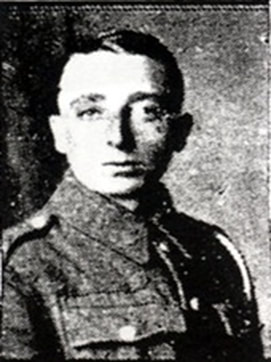
266232 Private
G. T. Brabrook
4th Bn. Yorkshire Regiment, transf. to (610832) 156th Coy. Labour Corps
24th October 1918, aged 20.
Plot I. B. 7.
Son of John and Margaret Brabrook, of Bury St. Edmund's.
G. T. Brabrook
4th Bn. Yorkshire Regiment, transf. to (610832) 156th Coy. Labour Corps
24th October 1918, aged 20.
Plot I. B. 7.
Son of John and Margaret Brabrook, of Bury St. Edmund's.
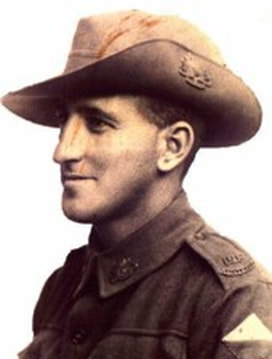
7392 Private
Bernard Manning Browning
28th Bn. Australian Infantry, A. I. F.
3rd October 1918, aged 30.
Plot IV. L. 10.
Emigrated to Australia with his cousin Charles John (who lost an eye during the Gallipoli campaign) and left behind a wife and two children.
His first day on the front line, being escorted across no man's land was hit by German Artillery. All 5 of his group were killed instantly.
Bernard Manning Browning
28th Bn. Australian Infantry, A. I. F.
3rd October 1918, aged 30.
Plot IV. L. 10.
Emigrated to Australia with his cousin Charles John (who lost an eye during the Gallipoli campaign) and left behind a wife and two children.
His first day on the front line, being escorted across no man's land was hit by German Artillery. All 5 of his group were killed instantly.

2635 Corporal
Frederick Charles Felgenhauer
57th Bn. Australian Infantry, A. I. F.
29th September 1918, aged 29.
Plot I. D. 11.
Son of John Frederick and Isabella Martha Felgenhauer, of Echuca, Victoria, Australia.
A farmer with two and half years in the Citizens' Military Forces (CMF) prior to enlisting on 2 August 1915, he embarked for overseas with the 6th Reinforcements from Melbourne on 27 October 1915 aboard HMAT Ulysses (A38). After arriving in Egypt, he transferred to the 57th Battalion and went with them to France in June 1916. He was promoted to Corporal (Cpl) on 11 October 1916 and then was wounded in the elbow by shrapnel at Beaumetz in March 1917. Rejoining the battalion from convalescence in England in November 1917, he was wounded in the back whilst the battalion was in the line at Wytschaete, Belgium, on 24 December 1917. He rejoined his unit again in May 1918. Cpl Felgenhauer was killed by German artillery fire whilst collecting a wounded American soldier during the attack on the Hindenburg Line at Bellicourt, France, on 29 September 1918.
Frederick Charles Felgenhauer
57th Bn. Australian Infantry, A. I. F.
29th September 1918, aged 29.
Plot I. D. 11.
Son of John Frederick and Isabella Martha Felgenhauer, of Echuca, Victoria, Australia.
A farmer with two and half years in the Citizens' Military Forces (CMF) prior to enlisting on 2 August 1915, he embarked for overseas with the 6th Reinforcements from Melbourne on 27 October 1915 aboard HMAT Ulysses (A38). After arriving in Egypt, he transferred to the 57th Battalion and went with them to France in June 1916. He was promoted to Corporal (Cpl) on 11 October 1916 and then was wounded in the elbow by shrapnel at Beaumetz in March 1917. Rejoining the battalion from convalescence in England in November 1917, he was wounded in the back whilst the battalion was in the line at Wytschaete, Belgium, on 24 December 1917. He rejoined his unit again in May 1918. Cpl Felgenhauer was killed by German artillery fire whilst collecting a wounded American soldier during the attack on the Hindenburg Line at Bellicourt, France, on 29 September 1918.
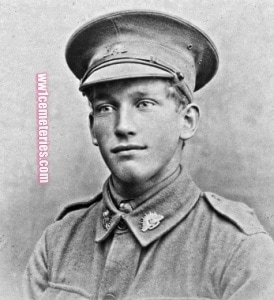
2162/A Private
George Harold Fowler, M. M.
59th Bn. Australian Infantry, A. I. F.
29th September 1918, aged 22.
Plot IV. S. 5.
Son of George and Lucretia Fowler; husband of Gladys C. Fowler, of 5, Perrett St., West Brunswick, Victoria, Australia. Native of Coburg, Victoria.
A carpenter from Drouin West, Vic prior to enlistment, Pte Fowler embarked with the 4th Reinforcements, 58th Battalion, from Melbourne on HMAT Orsova on 1 August 1916. After transferring to the 60th Battalion he was awarded the Military Medal. His citation reads "During the operations near Villers-Bretonneux, east of Amiens on 25th-27th April 1918, Private Fowler displayed conspicuous courage in performing the duties of stretcher bearer. He continued with ceaseless energy to attend and to carry wounded to the dressing station despite heavy sniping and artillery fire from the enemy. By his unselfish devotion to duty he was instrumental in the saving of life and his cool and gallant bearing set an example to all." Later transferring to the 59th Battalion, he was killed in action near Bullecourt, France on 29th September 1918, aged 22.
George Harold Fowler, M. M.
59th Bn. Australian Infantry, A. I. F.
29th September 1918, aged 22.
Plot IV. S. 5.
Son of George and Lucretia Fowler; husband of Gladys C. Fowler, of 5, Perrett St., West Brunswick, Victoria, Australia. Native of Coburg, Victoria.
A carpenter from Drouin West, Vic prior to enlistment, Pte Fowler embarked with the 4th Reinforcements, 58th Battalion, from Melbourne on HMAT Orsova on 1 August 1916. After transferring to the 60th Battalion he was awarded the Military Medal. His citation reads "During the operations near Villers-Bretonneux, east of Amiens on 25th-27th April 1918, Private Fowler displayed conspicuous courage in performing the duties of stretcher bearer. He continued with ceaseless energy to attend and to carry wounded to the dressing station despite heavy sniping and artillery fire from the enemy. By his unselfish devotion to duty he was instrumental in the saving of life and his cool and gallant bearing set an example to all." Later transferring to the 59th Battalion, he was killed in action near Bullecourt, France on 29th September 1918, aged 22.
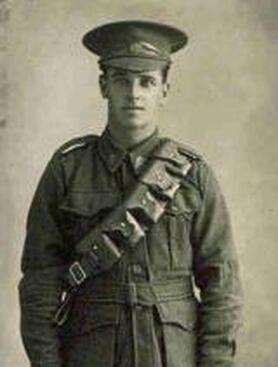
19790 Gunner
John (Jack) Edward Griffiths
8th Bde. Australian Field Artillery.
8th October 1918, aged 27.
Plot I. B. 11.
Son of Florence Ellen Preedy (formerly Griffiths), of 83, Albert Avenue, Maindee, Newport, Monmouthshire, Wales, and the late James Griffiths.
My Mother's cousin John (Jack) Edward Griffiths enlisted in the A.I.F. in Western Australia although he was from the UK and only there on holiday.
He joined A.I.F. 8th Bde. A.F.A. 29-9-1915. That was later crossed out on his papers and changed to 20th Battery on 6-10-1915. He then became a Gunner in the 30th Battery 01-04-1916. My Grandparents live 104 miles out of Kalgoorlie in the bush, Jack became the mail man for the area and travelled long distances. For a man he had beautiful handwriting and although he never married he was engaged to a lady in Melbourne, Victoria, when he died.
John (Jack) Edward Griffiths
8th Bde. Australian Field Artillery.
8th October 1918, aged 27.
Plot I. B. 11.
Son of Florence Ellen Preedy (formerly Griffiths), of 83, Albert Avenue, Maindee, Newport, Monmouthshire, Wales, and the late James Griffiths.
My Mother's cousin John (Jack) Edward Griffiths enlisted in the A.I.F. in Western Australia although he was from the UK and only there on holiday.
He joined A.I.F. 8th Bde. A.F.A. 29-9-1915. That was later crossed out on his papers and changed to 20th Battery on 6-10-1915. He then became a Gunner in the 30th Battery 01-04-1916. My Grandparents live 104 miles out of Kalgoorlie in the bush, Jack became the mail man for the area and travelled long distances. For a man he had beautiful handwriting and although he never married he was engaged to a lady in Melbourne, Victoria, when he died.
Jack Griffiths, the life and death of an ANZAC
(By Fay Widdicombe)
John (Jack) Edward Griffiths was born in Newport, Monmouthshire on the 17th June, 1891, the eldest of 9 children, his father died in 1902 and was survived by Florence, Jack's mother. In the early part of the twentieth century, Jack's grandfather moved to Australia, Jack followed soon afterwards when aged 20, it is believed that his brothers and sisters all stayed in the UK.
After arriving in Western Australia, Jack took a job as a mail driver in the Kalgoorlie area, sometimes driving long distances into the bush. In 1915, Jack enlisted in the Australian Imperial Forces, he originally joined the 8th Field Artillery Battalion on the 29th September, 1915, moving to the 20th Battery on the 6th October, 1915. He finally ended up as a gunner in the 30th Battery, moving there on the 1st April, 1916.
His medical papers show that he was 24 years of age when he joined up, he was 5ft. 4 inches tall with dark complexion and brown eyes, he weighed 125 pounds and his chest measurements were 34/36 inches. His religion was listed as Church of England. His medical was carried out in Perth, Western Australia and he was appointed to his unit for training at Blackboy Hill camp on November 18th, 1915.
After arriving in Western Australia, Jack took a job as a mail driver in the Kalgoorlie area, sometimes driving long distances into the bush. In 1915, Jack enlisted in the Australian Imperial Forces, he originally joined the 8th Field Artillery Battalion on the 29th September, 1915, moving to the 20th Battery on the 6th October, 1915. He finally ended up as a gunner in the 30th Battery, moving there on the 1st April, 1916.
His medical papers show that he was 24 years of age when he joined up, he was 5ft. 4 inches tall with dark complexion and brown eyes, he weighed 125 pounds and his chest measurements were 34/36 inches. His religion was listed as Church of England. His medical was carried out in Perth, Western Australia and he was appointed to his unit for training at Blackboy Hill camp on November 18th, 1915.
Jack (Back row 5th from left) and his comrades at Blackboy Hill Camp, Western Australia, this picture was taken on 14/10/1915. The caption reads "Are we downhearted, NO."
This card was sent from the front to a friend called Norm.
The card has a rhyme at the bottom:
When the Roos get ready for warrior work,
None will scatter or scare em:
And here we see him taking the Turk
Home to his empty harem!
On the rear of the card he wrote: Dear Norm, what do you think of me with my Christmas Turkey?
Sadly, further details of Jack's service in France are sketchy, although we do know that he was killed in action late in the war on the 8th October 1918. His war record lists him as being killed at Wiancourt, France, he was 27 years and 3 months. His details for his entry into the A. I. F. Roll of Honour were completed by his brother George Reginald Griffiths of 83 Albert Avenue, Maindee, Newport, Monmouthshire.
Jack was buried at Bellicourt British Cemetery, his record states plot 1, grave 13, although the Commonwealth War Graves Commission now list him as being buried in Plot 1. Row B. Grave 11.
The card has a rhyme at the bottom:
When the Roos get ready for warrior work,
None will scatter or scare em:
And here we see him taking the Turk
Home to his empty harem!
On the rear of the card he wrote: Dear Norm, what do you think of me with my Christmas Turkey?
Sadly, further details of Jack's service in France are sketchy, although we do know that he was killed in action late in the war on the 8th October 1918. His war record lists him as being killed at Wiancourt, France, he was 27 years and 3 months. His details for his entry into the A. I. F. Roll of Honour were completed by his brother George Reginald Griffiths of 83 Albert Avenue, Maindee, Newport, Monmouthshire.
Jack was buried at Bellicourt British Cemetery, his record states plot 1, grave 13, although the Commonwealth War Graves Commission now list him as being buried in Plot 1. Row B. Grave 11.
His family received the card above showing his grave
Later a further picture of the grave was acquired, Jack's wooden cross had now been replaced by the regular Portland stone headstone.
Jack Griffith's was born in Wales, he moved to Australia aged 20 and joined the A. I. F. to fight in the Great War, he never married but he was engaged to a lady from Melbourne. His young life ended in France aged just 27 and now he lies in a soldiers grave in Bellicourt British Cemetery, France. Jack was proud to fight both for the country of his birth and his adopted country, he was a truly brave man. May he rest in peace.
Later a further picture of the grave was acquired, Jack's wooden cross had now been replaced by the regular Portland stone headstone.
Jack Griffith's was born in Wales, he moved to Australia aged 20 and joined the A. I. F. to fight in the Great War, he never married but he was engaged to a lady from Melbourne. His young life ended in France aged just 27 and now he lies in a soldiers grave in Bellicourt British Cemetery, France. Jack was proud to fight both for the country of his birth and his adopted country, he was a truly brave man. May he rest in peace.
Pictures courtesy of Fay Widdicombe of Australia, if any member of Jack's family happen to see this, Fay has many images of Jack from his birth and would love to share them with his family. Please contact this site and we will put you in touch.

3947 Private
John Joseph Lavery
24th Bn. Australian Infantry, A. I. F.
5th October 1918
Plot VI. T. 8.
From South Melbourne, Vic. Pte Lavery enlisted on 30 November 1915 and embarked aboard HMAT Warilda on 8 February 1916. On 5 October 1918 he was killed in action at Montbrehain in the Bellicourt area of France.
John Lavery was going "Up the line" at St. Quentin when he was wounded in the back by a High Explosive shell, he died 30 minutes later. 2440 Corporal C. W. Richards was with him when he was hit and secured his personal effects which he later passed on to Private Lavery's brother.
John Joseph Lavery
24th Bn. Australian Infantry, A. I. F.
5th October 1918
Plot VI. T. 8.
From South Melbourne, Vic. Pte Lavery enlisted on 30 November 1915 and embarked aboard HMAT Warilda on 8 February 1916. On 5 October 1918 he was killed in action at Montbrehain in the Bellicourt area of France.
John Lavery was going "Up the line" at St. Quentin when he was wounded in the back by a High Explosive shell, he died 30 minutes later. 2440 Corporal C. W. Richards was with him when he was hit and secured his personal effects which he later passed on to Private Lavery's brother.
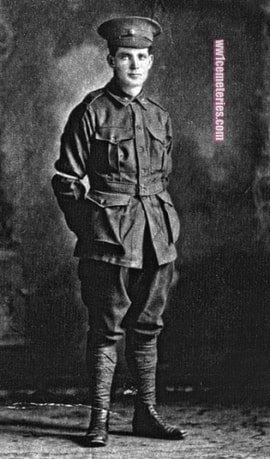
4085 Private
William McVeity
30th Bn. Australian Infantry, A. I. F.
30th September 1918, aged 30.
Plot V. J. 5.
Son of the late John and Maria McVeity. Native of Wandella, New South Wales.
From Cobargo NSW. A farmer prior to enlistment in July 1916, Pte McVeity embarked from Sydney on board HMAT Ceramic (A40) on 7 October 1916. After training in England, he arrived in France in February 1917. He was wounded in action at Polygon Wood, France, on 30 September 1917. After recovery and leave in England he rejoined his unit on 11 July 1918. Pte McVeity was killed in action at Nauroy, near Bellicourt, France, on 30 September 1918. He was 30 years of age.
Private McVeity was sheltering from a bombardment when a shell exploded killing both him and Lance Sergeant Webb (see below for image).
William McVeity
30th Bn. Australian Infantry, A. I. F.
30th September 1918, aged 30.
Plot V. J. 5.
Son of the late John and Maria McVeity. Native of Wandella, New South Wales.
From Cobargo NSW. A farmer prior to enlistment in July 1916, Pte McVeity embarked from Sydney on board HMAT Ceramic (A40) on 7 October 1916. After training in England, he arrived in France in February 1917. He was wounded in action at Polygon Wood, France, on 30 September 1917. After recovery and leave in England he rejoined his unit on 11 July 1918. Pte McVeity was killed in action at Nauroy, near Bellicourt, France, on 30 September 1918. He was 30 years of age.
Private McVeity was sheltering from a bombardment when a shell exploded killing both him and Lance Sergeant Webb (see below for image).

5706 Private
Herbert Leslie Parkes
17th Bn. Australian Infantry, A. I. F.
3rd October 1918, aged 19.
Plot V. R. 7
Brother of Amelia Parkes. Herbert Parkes' original grave marker in Bellicourt British Cemetery
Pictures courtesy of Craig Hill
Herbert Leslie Parkes
17th Bn. Australian Infantry, A. I. F.
3rd October 1918, aged 19.
Plot V. R. 7
Brother of Amelia Parkes. Herbert Parkes' original grave marker in Bellicourt British Cemetery
Pictures courtesy of Craig Hill

3144 Sergeant
John Aylan Salt
58th Bn. Australian Infantry, A. I. F.
30th September 1918, aged 24.
Plot I. C. 3.
Son of Thomas Aylan Salt and Mary Ann Salt, of "Polruan," Weston Rd., Guildford, England. Native of Hove, Sussex, England.
Pte Salt enlisted on 16 July 1915 and embarked from Melbourne aboard HMAT Osterley on 29 September 1915. He later served as a sergeant and was killed in action on 30 September 1918 at Bellicourt, France, whilst serving with the 58th Battalion.
John Aylan Salt
58th Bn. Australian Infantry, A. I. F.
30th September 1918, aged 24.
Plot I. C. 3.
Son of Thomas Aylan Salt and Mary Ann Salt, of "Polruan," Weston Rd., Guildford, England. Native of Hove, Sussex, England.
Pte Salt enlisted on 16 July 1915 and embarked from Melbourne aboard HMAT Osterley on 29 September 1915. He later served as a sergeant and was killed in action on 30 September 1918 at Bellicourt, France, whilst serving with the 58th Battalion.

568 Lance Sergeant
William Henry Webb
30th Bn. Australian Infantry, A. I. F.
30th September 1918, aged 22.
Plot V. J. 7.
Son of John and Elizabeth Webb, of Charles St., Abermain, New South Wales. Native of Catherine, Hill Bay, New South Wales.
Lance Sergeant Webb was sheltering from a bombardment when a shell exploded killing both him and Private William McVeity. (See above for image).
William Henry Webb
30th Bn. Australian Infantry, A. I. F.
30th September 1918, aged 22.
Plot V. J. 7.
Son of John and Elizabeth Webb, of Charles St., Abermain, New South Wales. Native of Catherine, Hill Bay, New South Wales.
Lance Sergeant Webb was sheltering from a bombardment when a shell exploded killing both him and Private William McVeity. (See above for image).


